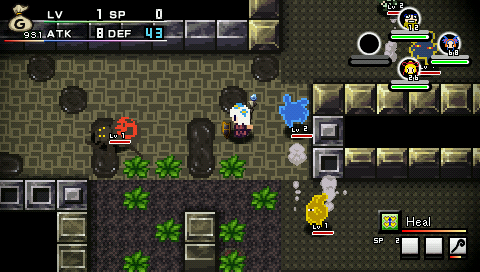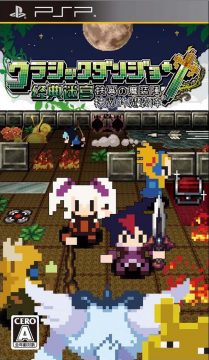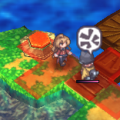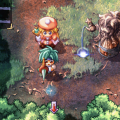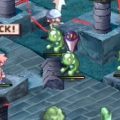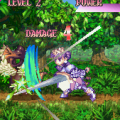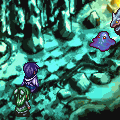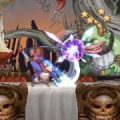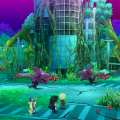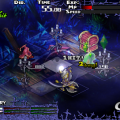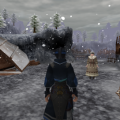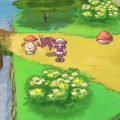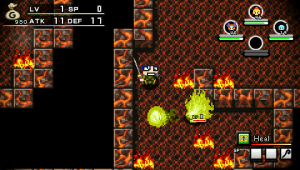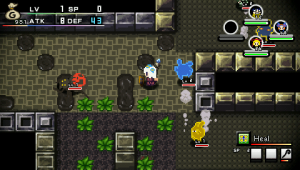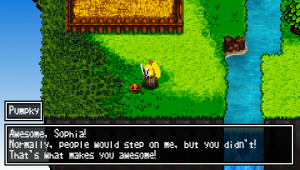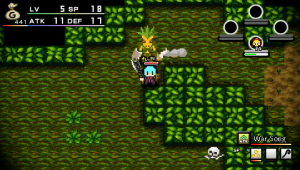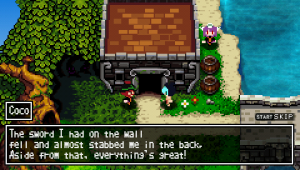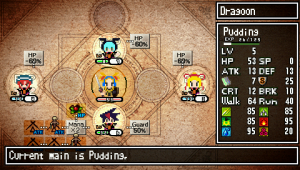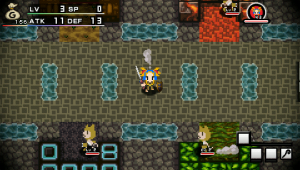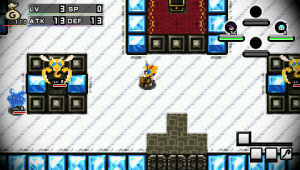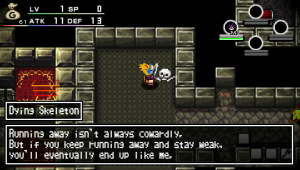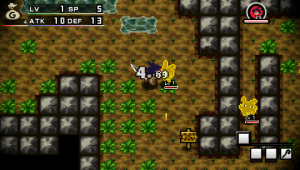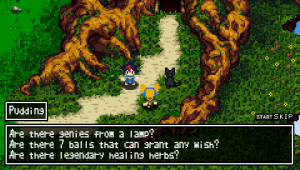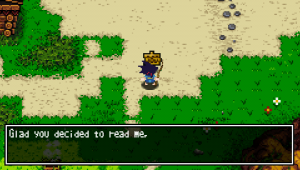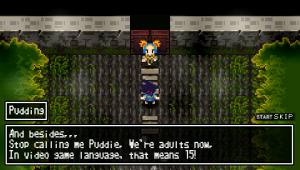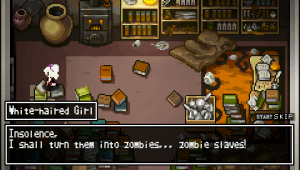Cladun: This is an RPG! is a unique game that lies in an interstice of retro sensibilities and modern complexity. After all, the name is a portmanteau of the Japanese name Classic Dungeon (also confirming how to pronounce the name). One thing, though, that may not be immediately apparent from seeing a description of the game is that it isn’t a classic style RPG in the Dragon Quest or Final Fantasy sense but much more of an action-based dungeon crawler. It’s not technically a Rogue-like, since there is no perma-death and you can keep your levels after you die, but there are still some similarities: the dungeons are littered with traps, dangers in the dungeons are quite high early on, much of the satisfaction in playing the game is in leveling up and receiving loot, and loot for killing enemies and opening treasure chests are often random. Many modern gamers have issue with these kinds of factors since these kinds of games tend to be especially unforgiving to those inexperienced in the genre and the specific game. Fortunately, with many dungeon crawlers, such as Sting’s Baroque, Chunsoft’s Shiren the Wanderer series and Nippon Ichi’s own Z.H.P becoming more prominent in the modern US marketplace, many people have gotten a taste for and tolerance for this sub-genre’s unusual traits.
Cladun is a difficult game, but death in this game, thankfully, is especially forgiving. When your character dies you do lose all of the items you found on that floor, but you keep half the experience and gold you earned there and you are simply restarted back at the hub world. Each floor in the main part of the game is essentially its own level that isn’t physically connected to the other floors. So once you beat one floor, you exit to the hub world and when you come back to the dungeon you may play the next floor or replay any previous ones. So when you die, you only lose your progress on one floor. These conveniences are a breath of fresh air in a sub-genre of games that is unusually unforgiving, but by no means take away from the actual difficulty of the levels. It’s really the best of both worlds and really works for the game.
The level structure of the game is interesting. The main quest involves traversing pre-made levels that each have a specific strategy to properly explore the entire floor. For instance, one early level contains treasure chests that are surrounded by blocks. The only way to break these blocks and open the chests is to trick a large charging enemy into breaking them before you kill the enemy for experience. Another involves keeping a certain type of enemy away from fire that would heal them due to their affinities. You learn the strategies for each level from advice from dead adventurers littering the dungeon floors and through trial and error. This can initially be frustrating, but you don’t lose much by dying during these levels and, like completing any puzzle, finding out how to complete each level can be quite rewarding even if it takes some grinding and a few deaths to figure it out. The game also contains a more traditional Rogue-like experience with the Random Dungeon (called the “Ran-geon”) that you eventually unlock. This dungeon retains a lot of the classic sub-genre rules: the dungeon has 100 floors, is completely random in level design, starts hard and becomes brutal, and you lose your loot and experience if you die. The main reason to want to play this dungeon (other than the challenge of simply playing it) is the random loot that can include much better equipment than you could buy or find in the main dungeon. The dungeon has random exits so that you may leave to retain your loot and experience. The Random Dungeon is a great addition to the game and gives another option to long-time Rogue-like players another option just in case they thought the main game was too forgiving.
Another unusual feature of the game is gameplay. Most dungeon crawlers and Rogue-likes are light on action, relying on the protagonist and enemies having to trade blows in turns. In Cladun, the fighting is action-oriented. If you choose to fight with a sword, your character has up to a three hit combo they can perform with each successive hit doing more and more damage. Running and defending are also a huge factor in how to battle. The temptation in most action games is to attack 95% of the time and defend and run away the rest much like we learned in the Legend of Zelda games from Link to the Past onwards. If you play this way, though, you will lose quickly and frequently. Defending does not block attacks completely but rather increases your Defense statistic many times over. The result is that you still take damage from attacks, but it’s much better than the alternative. Running of course gives you the option of avoiding the attacks altogether, but it has a price of sacrificing your base Defense stat many times lower. The result is that in order to survive in this game, you need a careful mixture of attacking, defending, and running most unlike most other action-based gameplay systems.
In many ways you could compare this aspect of the game to Demon’s Souls necessary cautiousness in every enemy encounter. Much of your success becomes noticing small holes in an enemy’s pattern for rare time for your avatar not to be obliterated but still get a hit in. Positioning becomes a real key to successful battles. Much like an earlier Ys game, your best bet is to attack the enemies from an angle, because a frontal assault is practically suicide. This action system, though carefully-crafted and deliberate, feels very sluggish for an action game. The time it takes your character to stop defending and commence an attack is too long, resulting in making your window in-between the enemies’ attacks way too small for comfort. This sort of system works for Demon’s Souls because you have much more freedom with how you can dodge an attack and control your character’s gameplay style through the weight of your equipment. In Cladun, your options are much smaller, especially early in the game resulting in the action being more stressful that fun. The benefit of an action-based system is giving the player more control over the character and the sluggishness fights against this benefit and makes the game more frustrating than it has to be.
Preparing for a dungeon level is different in this game as well. There are no support items whatsoever in this game. Potions, spell scrolls, and tonics are totally non-existent. Instead, the game litters the dungeon levels with good traps, as well as the normal bad ones that can poison and damage you. These good traps can heal your party, raise your attack stat, raise your defense stat, and even make your character’s walk speed faster. Luckily, it’s easy to identify the difference between the traps to tell you which ones to avoid and seek out. All preparation is done in making sure your character is well-equipped and the party properly arranged. Furthermore, stepping on a trap doesn’t immediately inflict any status – it simply fires a magic bolt from a wall. This allows you to inflict enemies with negative status effects, if you can lure them into the line of fire.
The intricate and unique party system isn’t well-explained by the game’s tutorial and it desperately needs to be. The way it works is that you unlock characters as you complete the dungeon levels. You then must pick one of these characters to be your Main Character, or the one that you directly control in combat. The rest are potential Sub Characters. They don’t cast spells for you or help you attack as with most party systems. Instead, Sub Characters are really there to supplement your Main character’s abilities. You must pick what is called a Magic Circle which is essentially a grid in which to place your Sub Characters around your Main. Subs essentially act as shields to your main character for the most part. The Sub that you put in front of your character on the grid absorbs any damage that you incur from your front, the sub to your left side always absorbs any damage from your left side, and so on. If the sub on a particular side dies, the Main will incur the damage directly on that side. Many of these grids also allow these Subs to give you defense, spirit, and attack bonuses as well that they will only bestow if they are alive. Each character has their own unique Magic Circles, which they receive at certain experience levels) with different formations and different detractions and benefits.
There are many Magic Circles that even have multiple layers of Sub Characters that protect the Main. However, most of these grids prevent the Subs from using all of their base HP to protect your Main. Luckily, Subs all gain experience when they are in the party, whether they live through the dungeon level or not. Newly unlocked characters, thus, are best used as Subs before being used as a Main so they may level up in this state first. This system takes a LOT to get used to as the implementation of this kind of system is really unprecedented, but ends up being fun to experiment and Magic Circles are never completely perfect, so weighing the good and bad factors of each grid takes some serious thought. It’s great to have a unique system that incorporated a lot of new ideas, but it’s not user friendly and there’s something to be said about the benefits of easy accessibility.
The story structure is usual as well. The story stars wimpy, unlikely boy Souma and his bossy and adventurous female friend Pudding (yes…Pudding) who seek out the whimsical magical (and loot filled) world Arcanus Cella, created by a witch named Despina. The story is unlocked in dribs and drabs as you complete specific dungeon floors. The story surrounds Despina’s relationship (and annoyance) with the people who start to populate the world she made, which consists of the hub-world and the dungeon. As you proceed through the game, you unlock more and more characters that populate the hub-world and serve different functions. Much like the classic Soul Blazer, you must unlock characters to populate the town and serve their functions such as merchant, bartender, and even barber. As you unlock these characters, you unlock options and services. You can also technically “end” the game any time you want by returning through the rabbit hole, though the specific ending is different depending on your progress in the game with comic results. The dialog is generally silly and odd to point where you have to wonder whether the game was poorly translated or simply ridiculous to begin with. It’s probably a bit of both considering the goofiness of the events and the poor translation may be intentional to fit into the retro theme. Either way, this sub-genre is traditionally devoid of story and dialog (with a few exceptions) and it’s nice to have story threads to unlock as rewards with your progression.
With a name like Classic Dungeon, you can expect a lot of retro throwbacks in terms of presentation. The game’s aesthetic is characterized by cute, colorful, well-animated pixel art. Those who loved the pixel-art in the earlier PSP throwback Half-Minute Hero can expect a similar style here. The game is also loaded with customizable options. You can choose to pick between a MIDI-orchestrated or chiptune soundtrack on the fly, much like with The Dark Spire on DS. This game’s regular soundtrack is fantastic, full of many acoustic folksy tunes that really add to the charm. The chiptune versions tend to be too plain, losing much of the folk quality that makes the orchestral versions so much character. On top of all of the all of the characters you unlock, you can also create your own main character, much like rolling a new character at the beginning of a classic RPG, and then giving them a specified class and look. The game even gives you the option of changing the appearance of the pre-made characters once the barber is unlocked. You can really only change their face and hair, since the rest of their sprite is determined by their equipment.
Cladun: This is an RPG! is a wacky, inventive take on the traditional dungeon crawler. It has some great presentation and interesting compromises in combining the old with the new. As with almost all dungeon crawlers this game is not for people unfamiliar with the sub-genre. For someone who likes this kind of game, it can be fun. Unfortunately, the game is greatly hurt by its sluggish, action-based battle system. If this important factor were more finely tuned and easier to decipher the game, it would be more accessible to a bigger audience. As it is, only hardcore fans of the sub-genre will really enjoy this flawed but unique game for its unique party system and rewarding level completion.
The Japanese version offered some free DLC after its release. All of this is included with the English version.
